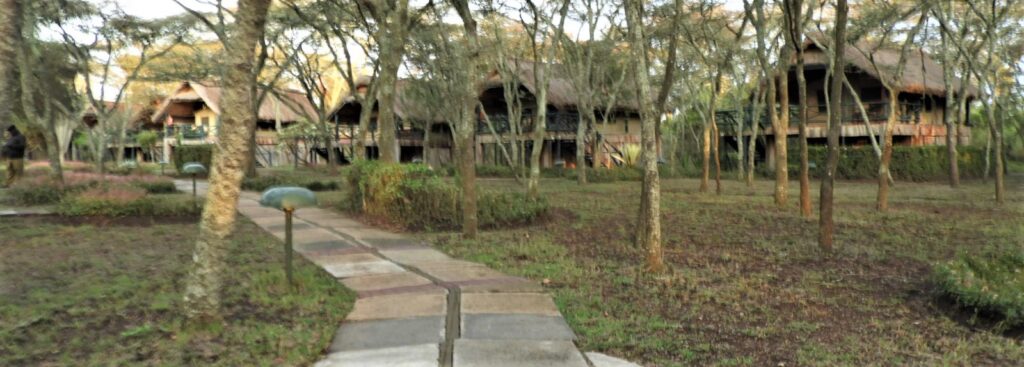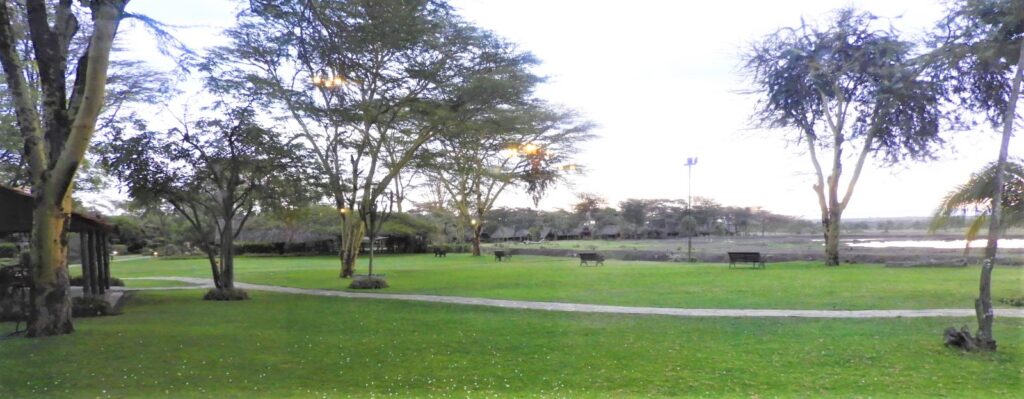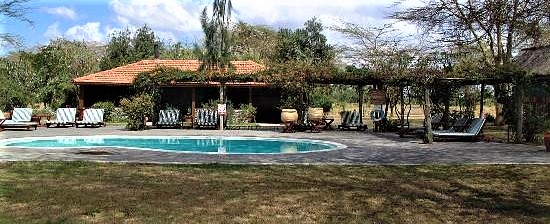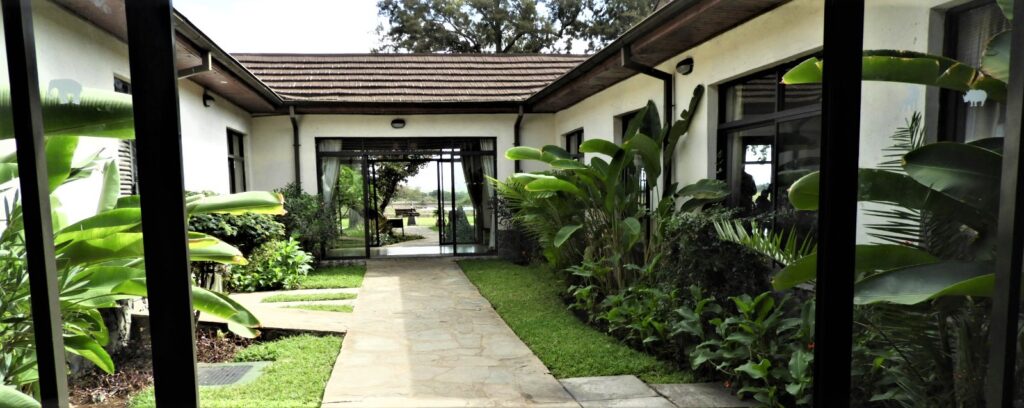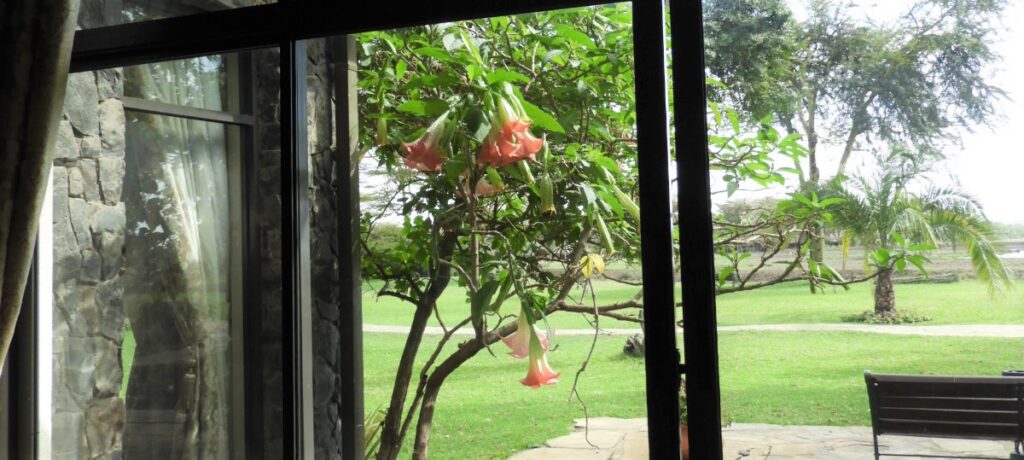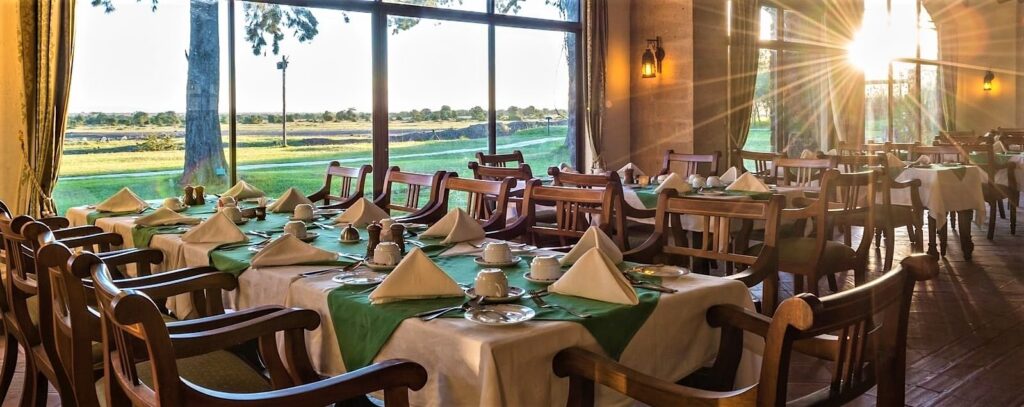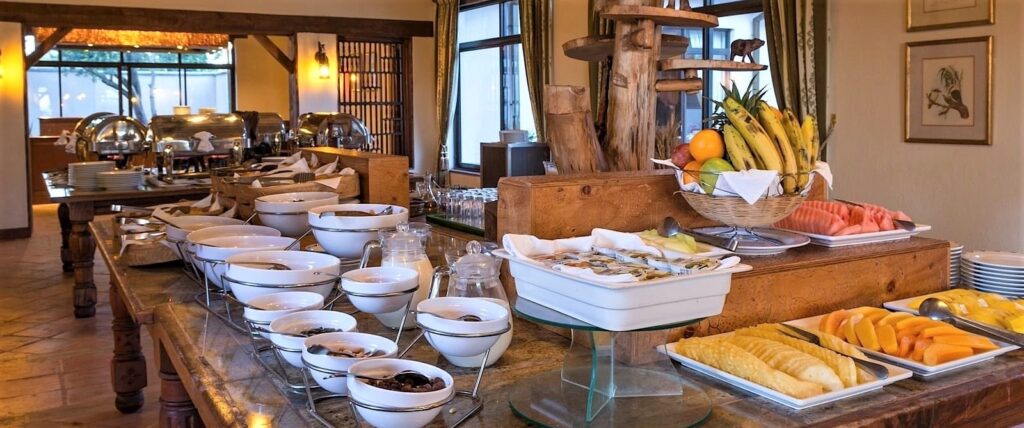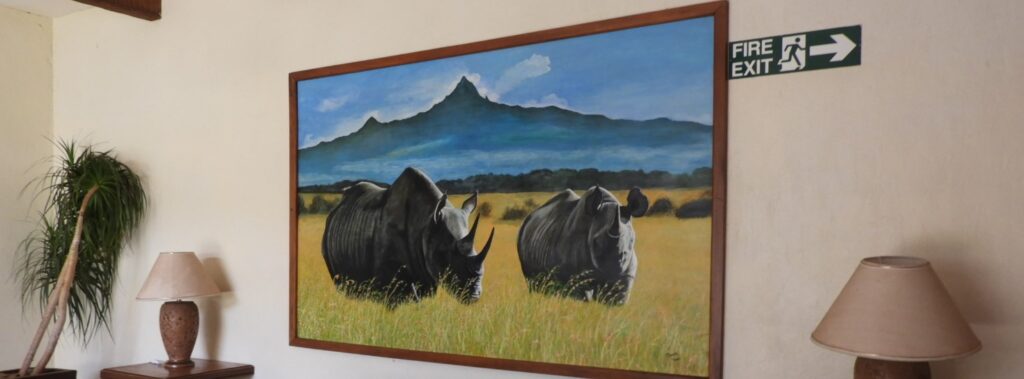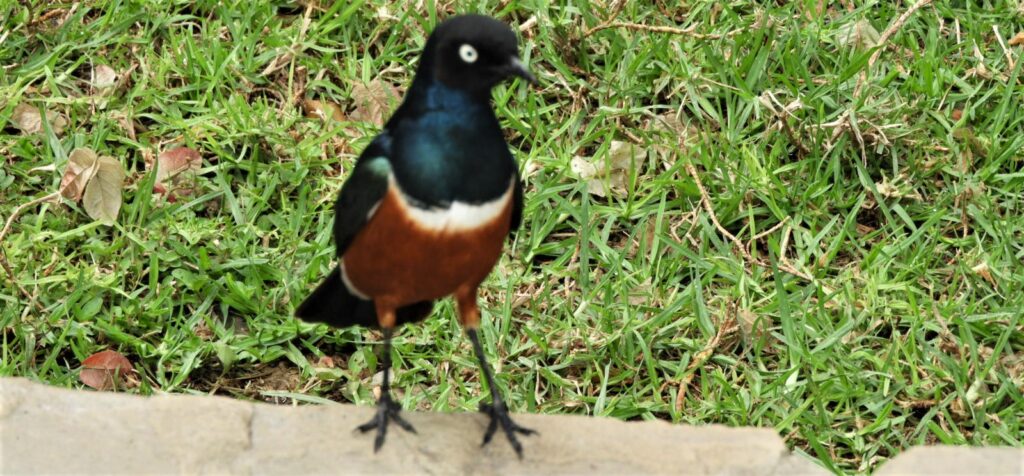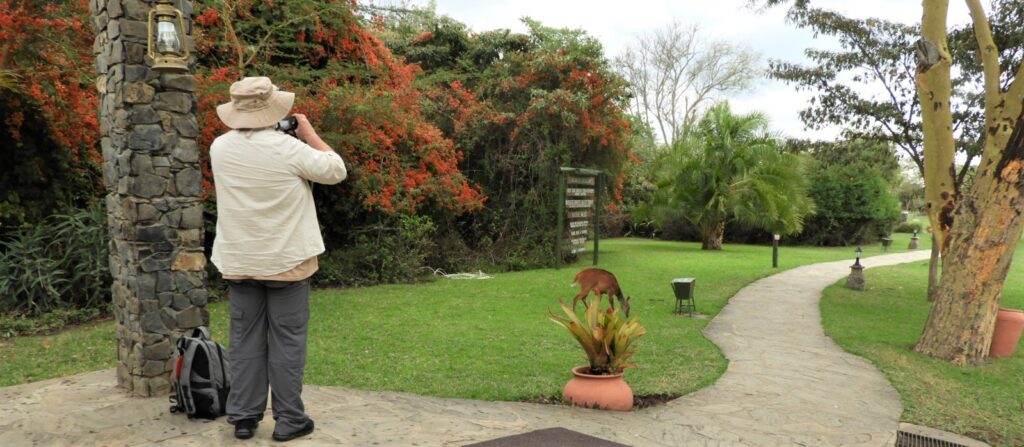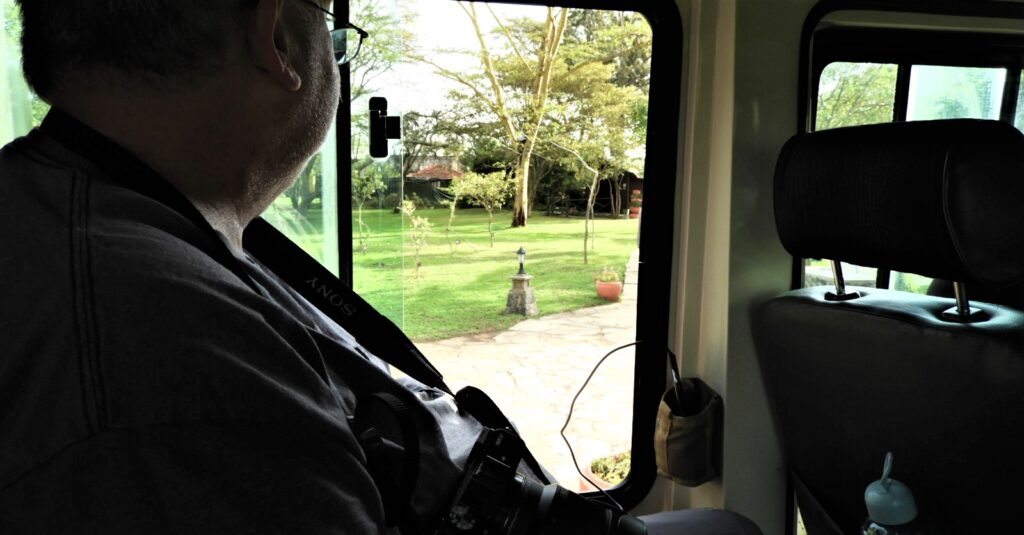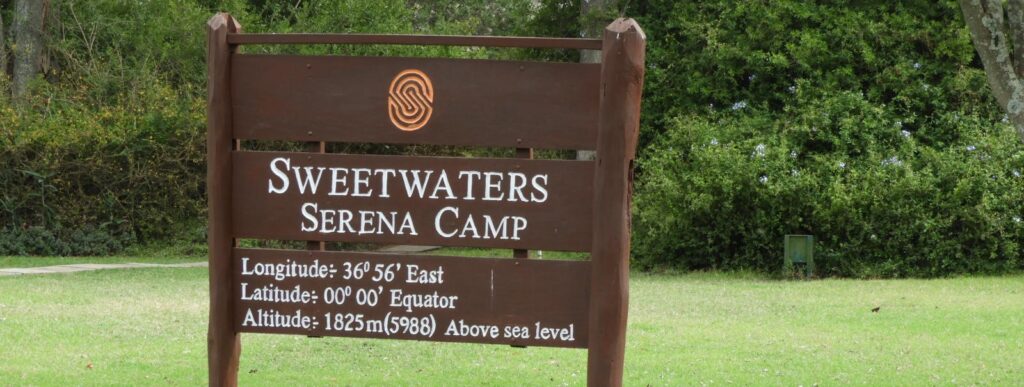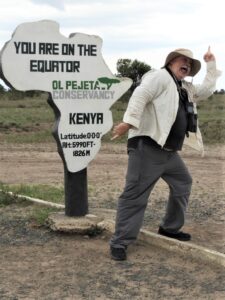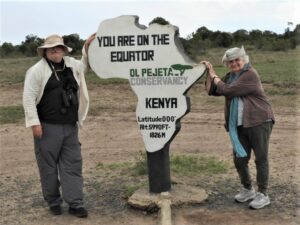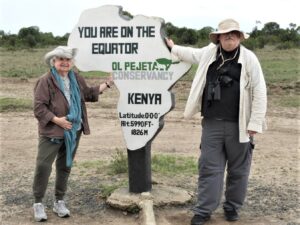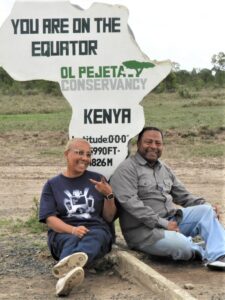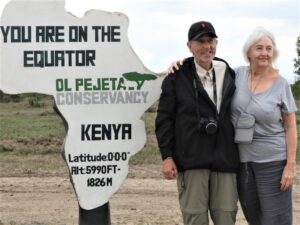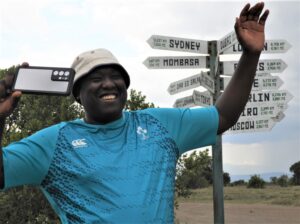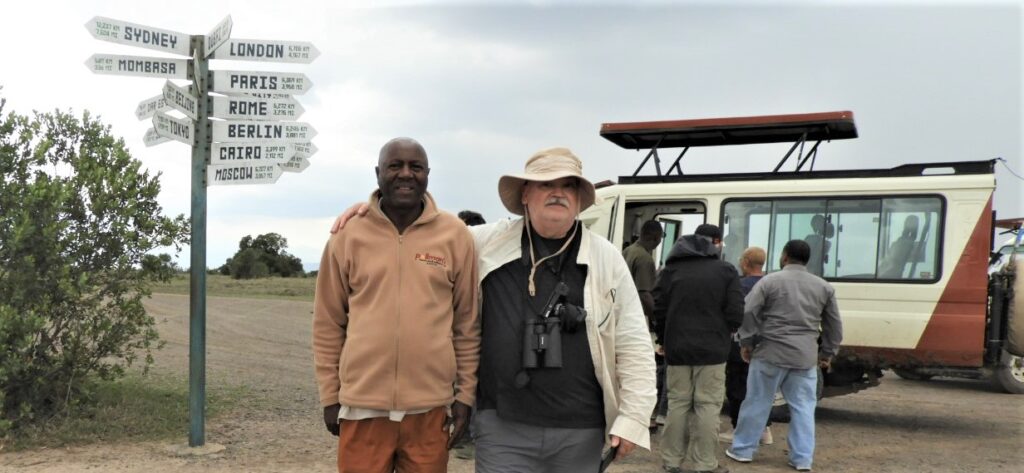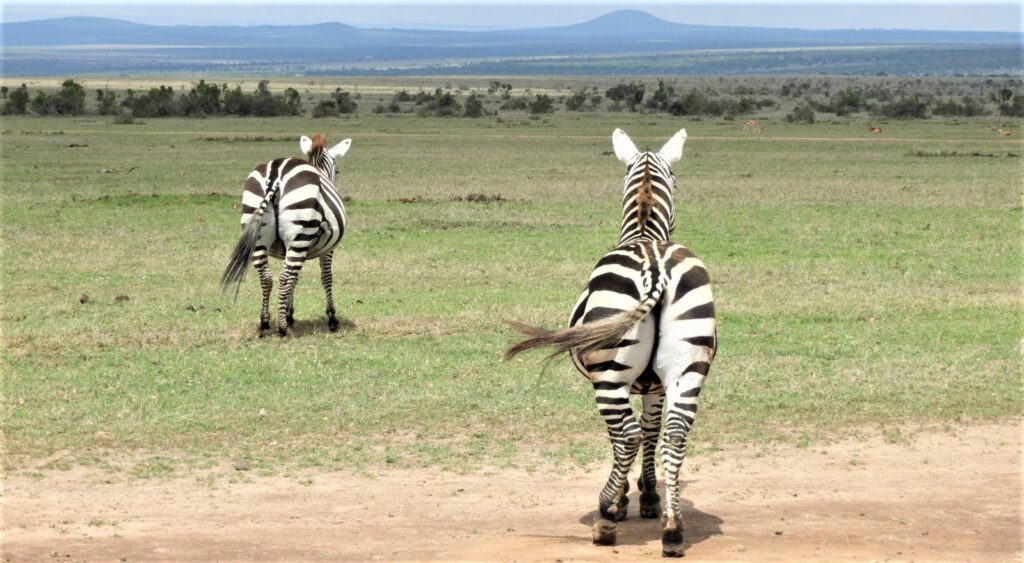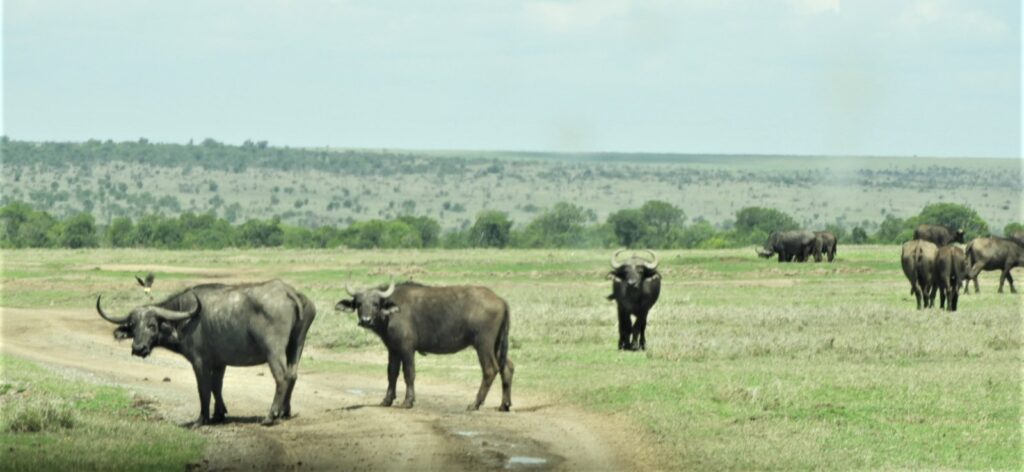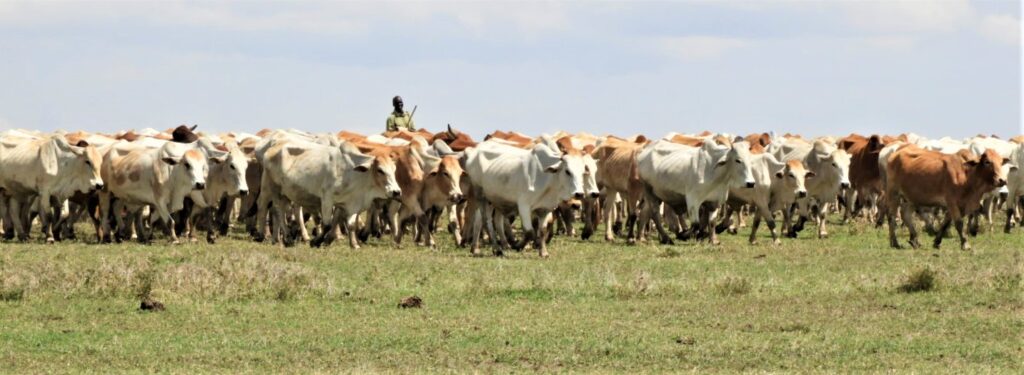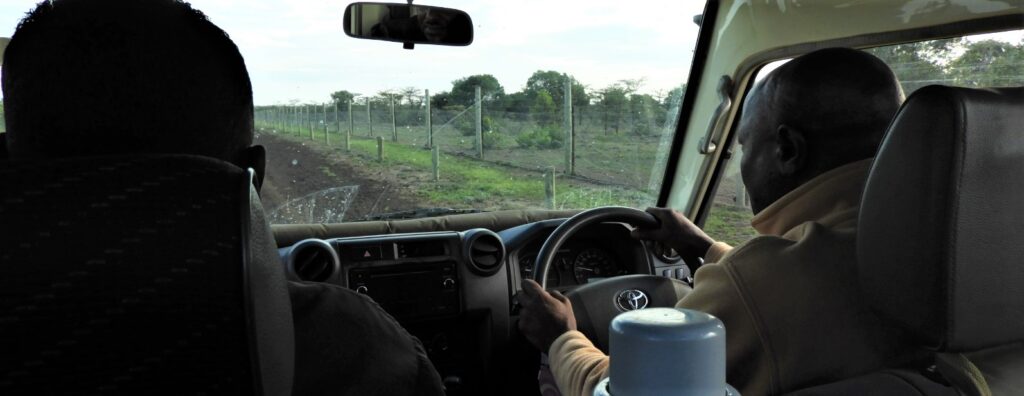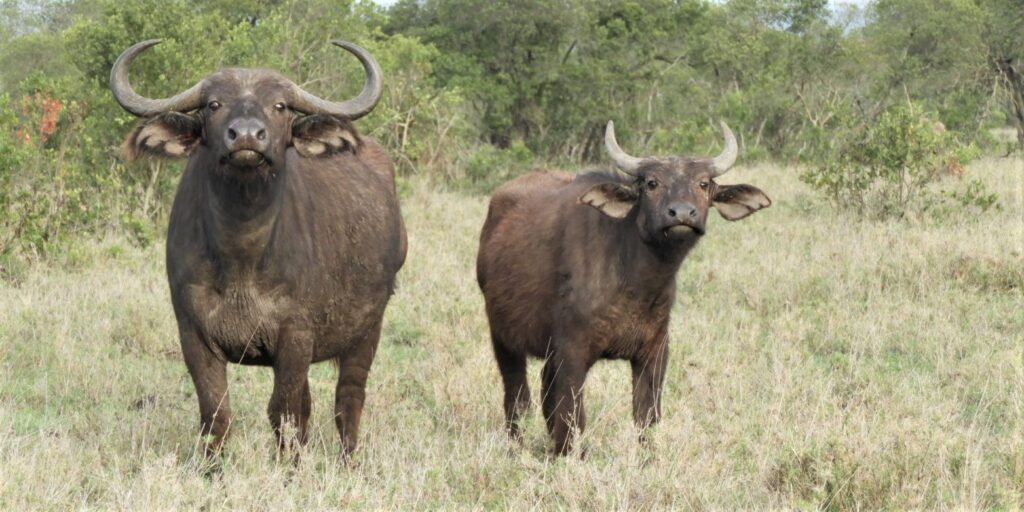‘2022’ Category
» posted on Wednesday, September 14th, 2022 by Linda Lou Burton
Everything’s Rosy
Linda Lou Burton posting from Sweetwaters Serena Camp, Ol Pejeta Conservancy, Nanyuki, Kenya –I’d heard about sunrises on the Equator, coming in fast, and glorious. It was true! We were packed; it was Check-Out-Move-On-Day; a day spent riding; crossing the Equator headed south this time, destination Lake Nakuru. But the pull of “where we are” was strong; it was hard to leave our porch by the water hole. Our squawky guinea fowl were up. Our impalas were up. Our neighbors were up. And now, the sun went crazy, sliding over Mt Kenya, over the guinea fowl, over the impalas, over us, in an outrageous fit of morning.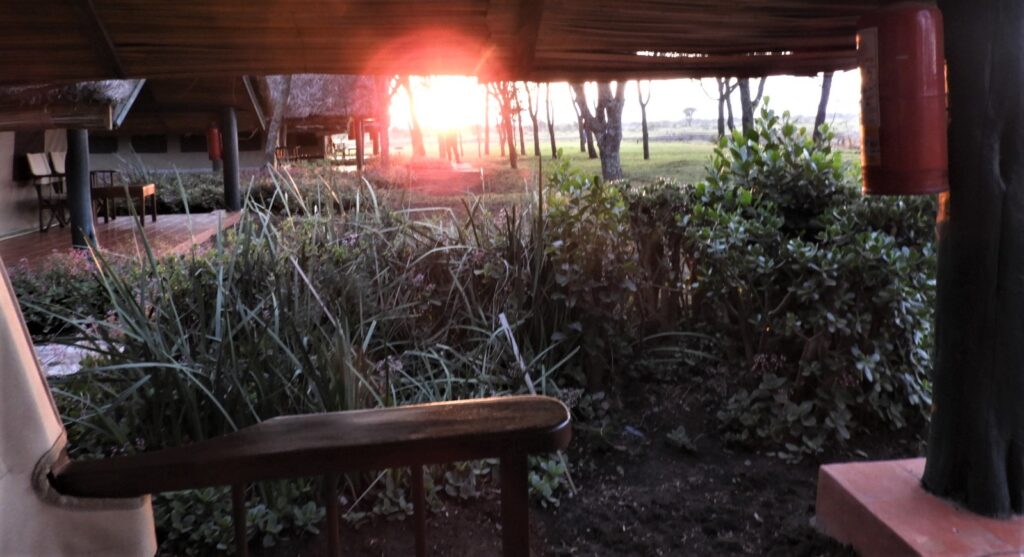
Our luggage was picked up an hour ago, loaded into the 4×4 named Simba. Our breakfast was waiting in the dining hall. Into my wheelchair and down the path around the water hole, past the pool I never had time to sit by. Into the main building, the dining room, our table, the buffet. Cantaloupe, walnut muffins, cheese omelet cooked up special for Judy and for me. Everybody talking, pass the butter please.
On to the office to check out, pay the bill for laundry done, chat with Maureen as we pass the painting of the rhinos and Mt Kenya on a last restroom stop, gather at the front, admire the wide-eyed little bird, the tree, the lawn. Slowly, slowly (pole, pole) down the walk, a helping hand from Daniel as I climb the ladder-step and take my seat. Phones charging, water bottles filled, looking out, looking back, Sweetwaters Serena, you are an awesome place. Goodbye!
Sweetwaters Serena Tented Camp, Nanyuki, Kenya https://www.serenahotels.com/sweetwaters
» posted on Tuesday, September 13th, 2022 by Linda Lou Burton
Lions. Not Sleeping.
 Linda Lou Burton posting from Sweetwaters Serena Camp, Ol Pejeta Conservancy, Nanyuki, Kenya – The lion may be the most misrepresented animal of all. Maybe it’s Disney’s fault, or maybe Solomon Ntsele’s. Solomon was a South African musician who wrote the song “Mbube” (lion) in 1939, which over time became known as “The Lion Sleeps Tonight,” which, well you know what Disney did with that. As well as folk artists, pop singers, and gospel choirs from pretty much all over the world who recorded the song. (You’re probably humming it right now.) But let’s get back to the lion, and its habits.
Linda Lou Burton posting from Sweetwaters Serena Camp, Ol Pejeta Conservancy, Nanyuki, Kenya – The lion may be the most misrepresented animal of all. Maybe it’s Disney’s fault, or maybe Solomon Ntsele’s. Solomon was a South African musician who wrote the song “Mbube” (lion) in 1939, which over time became known as “The Lion Sleeps Tonight,” which, well you know what Disney did with that. As well as folk artists, pop singers, and gospel choirs from pretty much all over the world who recorded the song. (You’re probably humming it right now.) But let’s get back to the lion, and its habits.
The lion neither lives in the jungle, as the song implies, nor does the lion sleep at night! Lions live on the savannah, wide-open grasslands, so they can SEE their prey, and run fast to catch something good to eat, like animals that slowly graze – zebras, or baby buffalo. And mostly, the lion HUNTS at night. Lions are cats, and in the daytime they like to sleep, relax, laze around. One reason is practical – they have few sweat glands, so conserve energy during the day and move around at night when it is cooler. And they have terrific night vision.
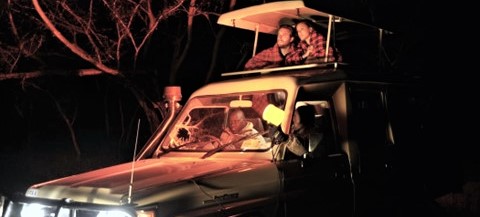 That is why we chose a NIGHT GAME DRIVE. Of all the parks we are scheduled to visit, only Ol Pejeta allows nighttime game drives. And tonight was our last night here. So, no brainer, we were climbing into an Ol Pejeta 4×4 at 9 PM, ready to prowl. Five of us were daring – besides me, and Rick, were Otis and Venita and Judy. Our local driver knew the routes, our spotter knew what to watch for; both certified to do, and go, just where allowed to insure the protection of both the animals we hoped to see, and US. We were not to put even a
That is why we chose a NIGHT GAME DRIVE. Of all the parks we are scheduled to visit, only Ol Pejeta allows nighttime game drives. And tonight was our last night here. So, no brainer, we were climbing into an Ol Pejeta 4×4 at 9 PM, ready to prowl. Five of us were daring – besides me, and Rick, were Otis and Venita and Judy. Our local driver knew the routes, our spotter knew what to watch for; both certified to do, and go, just where allowed to insure the protection of both the animals we hoped to see, and US. We were not to put even a 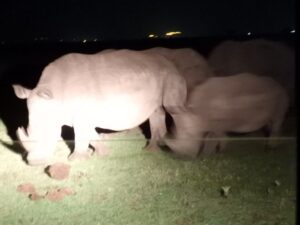 pinkie finger outside the vehicle; no sticking a camera out, or making noise. The top opened up, so standing was allowed. And we could have our side windows open. A stack of folded blankets was provided; warm plaid flannel. (Ol Pejeta’s photo.)
pinkie finger outside the vehicle; no sticking a camera out, or making noise. The top opened up, so standing was allowed. And we could have our side windows open. A stack of folded blankets was provided; warm plaid flannel. (Ol Pejeta’s photo.)
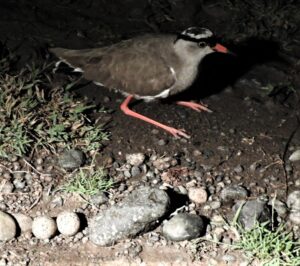 We came upon a few buffalo (curled on the ground asleep), and a herd of antelope who took off when they saw our light. We spotted a baby rhino and mom eating; maybe the ones we’d seen in the daylight? Then, something new – a spotted hyena. We stopped to watch; baby very wary of our sight and sound; mama patiently waiting for us to move on. “There’s a land plover,” our driver said, pointing to a small bird right at the edge of the road. “She’s guarding her eggs.” The land plover mother-to-be didn’t move, she stood her ground. See her two speckled eggs, right between the rocks? I’d never have noticed in the daylight.
We came upon a few buffalo (curled on the ground asleep), and a herd of antelope who took off when they saw our light. We spotted a baby rhino and mom eating; maybe the ones we’d seen in the daylight? Then, something new – a spotted hyena. We stopped to watch; baby very wary of our sight and sound; mama patiently waiting for us to move on. “There’s a land plover,” our driver said, pointing to a small bird right at the edge of the road. “She’s guarding her eggs.” The land plover mother-to-be didn’t move, she stood her ground. See her two speckled eggs, right between the rocks? I’d never have noticed in the daylight.
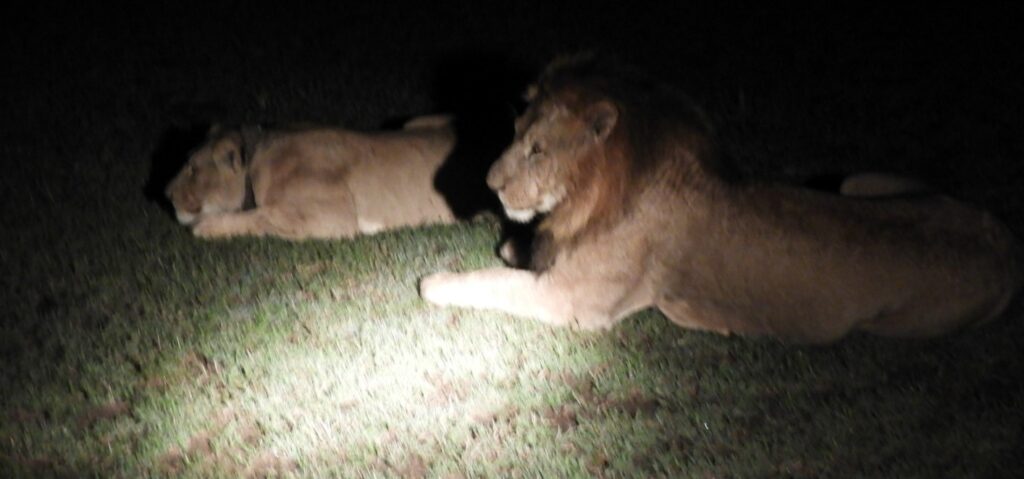 We turned down another road in the dark (and starry) night, and suddenly our spotter’s light flashed across our “gift of the evening.” Lions! Our driver pulled beside a male and female lion, right there, not 10 feet from our open windows. Everybody but me videoed the skit that played out next (I was too excited to switch camera settings in the dark).
We turned down another road in the dark (and starry) night, and suddenly our spotter’s light flashed across our “gift of the evening.” Lions! Our driver pulled beside a male and female lion, right there, not 10 feet from our open windows. Everybody but me videoed the skit that played out next (I was too excited to switch camera settings in the dark).
It was better than anything on Saturday Night Live as the male (Leo?) stood and began to roar. Not at us, but at his female companion (Muffin?). She gave him a “Not tonight, dear,” look, then got up and walked to the other side of our vehicle, definitely not in the mood. Leo followed her, and roared again. Muffin left her scent in the edge of a ditch (meaning, she peed) and lay back down. Leo checked her scent and got the message: Not gonna happen tonight. So Leo lay back down beside his lady love. “Oh there’s nothing romantic about it,” our driver said, explaining. “Mating is just a job in the animal kingdom.” 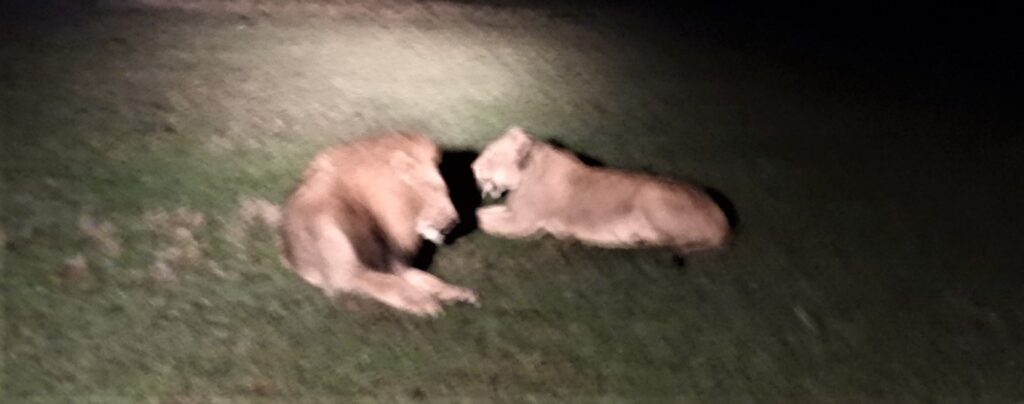
Solomon’s song was right about these lions, this night. They DID sleep. We laughed all the way back to camp.
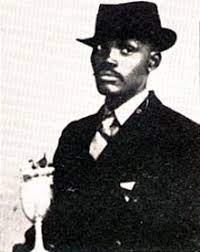 A postscript about Solomon’s song; he grew up a herdboy watching over cattle; the song was considered a lullaby, assuring his herd of “no danger” from the lions; another interpretation is sinister – perhaps a Zulu code about driving the British out of South Africa? Solomon died in 1962, impoverished, not profiting from all those millions of albums sold with his song on them, though his estate did file a lawsuit against Disney in 2006 with some benefit.
A postscript about Solomon’s song; he grew up a herdboy watching over cattle; the song was considered a lullaby, assuring his herd of “no danger” from the lions; another interpretation is sinister – perhaps a Zulu code about driving the British out of South Africa? Solomon died in 1962, impoverished, not profiting from all those millions of albums sold with his song on them, though his estate did file a lawsuit against Disney in 2006 with some benefit.
» posted on Tuesday, September 13th, 2022 by Linda Lou Burton
Grandma Hopes
Linda Lou Burton posting from Sweetwaters Serena Camp, Ol Pejeta Conservancy, Nanyuki, Kenya – I was thinking of Elisha as I rested on my tent porch Tuesday afternoon. The gang had set off on another Game Drive after lunch, so I had some  quiet time. I was also thinking of events transpiring in Nairobi at that very moment. William Ruto was being inaugurated as the 5th President of Kenya. It was happening in that big stadium we’d passed on our Sunday tours, the Moi International Sports Center, where 60,000 people could gather. Today had been declared a national holiday. The election had been hard fought, I wondered how things were going.
quiet time. I was also thinking of events transpiring in Nairobi at that very moment. William Ruto was being inaugurated as the 5th President of Kenya. It was happening in that big stadium we’d passed on our Sunday tours, the Moi International Sports Center, where 60,000 people could gather. Today had been declared a national holiday. The election had been hard fought, I wondered how things were going.
Do you know anything of Kenyan history? Are you aware that Kenya was colonized by the British in 1895? It was 1902 when those fertile highlands I’ve been riding through the last few days were opened to white settlers (hence Karen Blixen’s 6,000-acre coffee plantation in 1913). Fast forward to 1963, when the volatility of “whose land is it, anyhow?’(call it a revolution) brought about independence, of a sort, for the folks who lived there first.
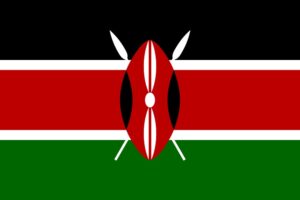 Today, Kenya, a small and beautiful multi-ethnic country on the east coast of Africa with 42 tribes and about 60 languages (English and Swahili most prolific) is a “presidential representative democratic republic.” Over the last 59 years it has altered its constitution many times; political parties have come and gone; and corruption has left its mark.
Today, Kenya, a small and beautiful multi-ethnic country on the east coast of Africa with 42 tribes and about 60 languages (English and Swahili most prolific) is a “presidential representative democratic republic.” Over the last 59 years it has altered its constitution many times; political parties have come and gone; and corruption has left its mark.
Will William Ruto make a difference?
Wait, you may be thinking. He is only the 5th president in 59 years? Well yes, here’s the list; fascinating to read about who did the most good, and the most harm, during their long terms. Worth looking them up if you want to dig deeper. From 1963-1964 British rule was winding down with Queen Elizabeth II as monarch; Jomo Kenyatta was Prime Minister.
- 1964-1978: Jomo Kenyatta, President (14 years)
- 1978-2002: Daniel Moi, President (24 years)
- 2002-2013: Mwai Kibaki, President (11 years)
- 2013-2022: Uhuru Kenyatta, President (son of Jomo, 9 years)
The Constitution of 2010 set term limits at 5 years, allowing two consecutive terms.
Rick arrived back at our tent a little after 5. “Guess what!” he said. “After the Game Drive we got to watch a video of the inauguration on TV!” He showed me a picture he’d taken of the screen, and told me that the proceedings went smoothly.
“Speaking of pictures,” I said, “you took a picture of Elisha and me this morning. Can I see that?” Elisha’s story, and Ruto’s inauguration seemed somehow connected in my mind.
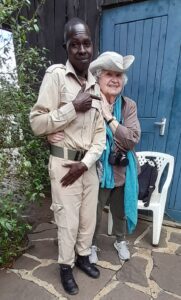 Here’s the picture of Elisha and me. I met him today, just before we stopped at the Equator. I was sitting in a white chair this time, in the shade outside the Chimpanzee Sanctuary’s Visitor Center. Once again, I’d requested a place to sit while everyone else stood, and walked, and followed the guide along the pathways to the enclosures. And once again, someone had been asked to “look after” the gray-headed lady who moved slowly, slowly, “pole, pole.” After we’d exchanged names, I asked how long he’d worked there. “Two years,” he answered, and then Elisha told me his story.
Here’s the picture of Elisha and me. I met him today, just before we stopped at the Equator. I was sitting in a white chair this time, in the shade outside the Chimpanzee Sanctuary’s Visitor Center. Once again, I’d requested a place to sit while everyone else stood, and walked, and followed the guide along the pathways to the enclosures. And once again, someone had been asked to “look after” the gray-headed lady who moved slowly, slowly, “pole, pole.” After we’d exchanged names, I asked how long he’d worked there. “Two years,” he answered, and then Elisha told me his story.
“I first got a job building fences,” he said. “I was the oldest of seven children and since my father had died, it was my responsibility to look after the family. My mother determined that I get the best education possible, so I did. I graduated with honors! But the only job I could find right away was as a fence builder, digging post holes, and stringing wire. I was able to bring a little money in with that, but knew I had to do better. So I kept applying for jobs, every time I learned of an opening. It took me five years to get this job,” he said, looking around the grounds of the Sanctuary. “I put in four applications and had four interviews. I actually cried when I got the letter telling me I was hired. There are simply more college graduates than jobs available.” We continued talking for a long while; about life, about responsibility, about how important our family is.
And then the group finished the tour and came to find me. Someone asked Elisha if they could get his picture in his handsome uniform, and he replied “Only if you get her picture with me. She’s my Grandma.” I stood up and gave Elisha a very proud grandmotherly hug.
William Ruto’s inaugural address included these words.
It is time for us to stem the tide of youth unemployment. Every year, 800,000 young people join the workforce and over 600,000 of them do not find opportunities for productive work. Moreover, our young people in cities and towns face very hostile environments, many times treated as a nuisance….Our immediate agenda is to create a favorable business and enterprise environment…and support people in the informal sector to organize themselves into stable, viable and creditworthy business entities. This is the essence of the bottom-up economic model, which creates a path for traders and entrepreneurs to build linkages, experience safety, and enjoy security.
I so hope that works out.
» posted on Tuesday, September 13th, 2022 by Linda Lou Burton
Smack Dab in the Middle
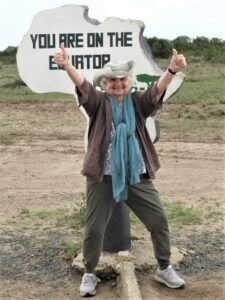 Linda Lou Burton posting from Sweetwaters Serena Camp, Ol Pejeta Conservancy, Nanyuki, Kenya – Here’s the second reason I went to Africa. First Karen Blixen’s house. Now, the EQUATOR. I’ve been to the Arctic and the Antarctic, now I was smack dab in the middle, the fattest part of EARTH. Hot dog!
Linda Lou Burton posting from Sweetwaters Serena Camp, Ol Pejeta Conservancy, Nanyuki, Kenya – Here’s the second reason I went to Africa. First Karen Blixen’s house. Now, the EQUATOR. I’ve been to the Arctic and the Antarctic, now I was smack dab in the middle, the fattest part of EARTH. Hot dog!
I wasn’t the only person there who was acting like a nut. We’d been sitting in the 4x4s since early morning and this was our last stop before lunch. We were running around like fools. “Get it on record! We’re at the Equator!”
I mean, this is serious stuff. That big tall sign was bragging too, with a bunch of “get this” facts about THE EQUATOR.
- It has the fastest sunrises and sunsets.
- It crosses through 13 different countries.
- It always has exactly 12 hours of day and 12 hours of night.
- It has just two equinoxes when the sun is directly above – March and September.
- It holds the world’s greatest concentration of biodiversity.
- It passes through 50% of the world’s rainforest in three countries – Brazil, Congo, and Indonesia.
- Only 20% of the world’s population live below the Equator.
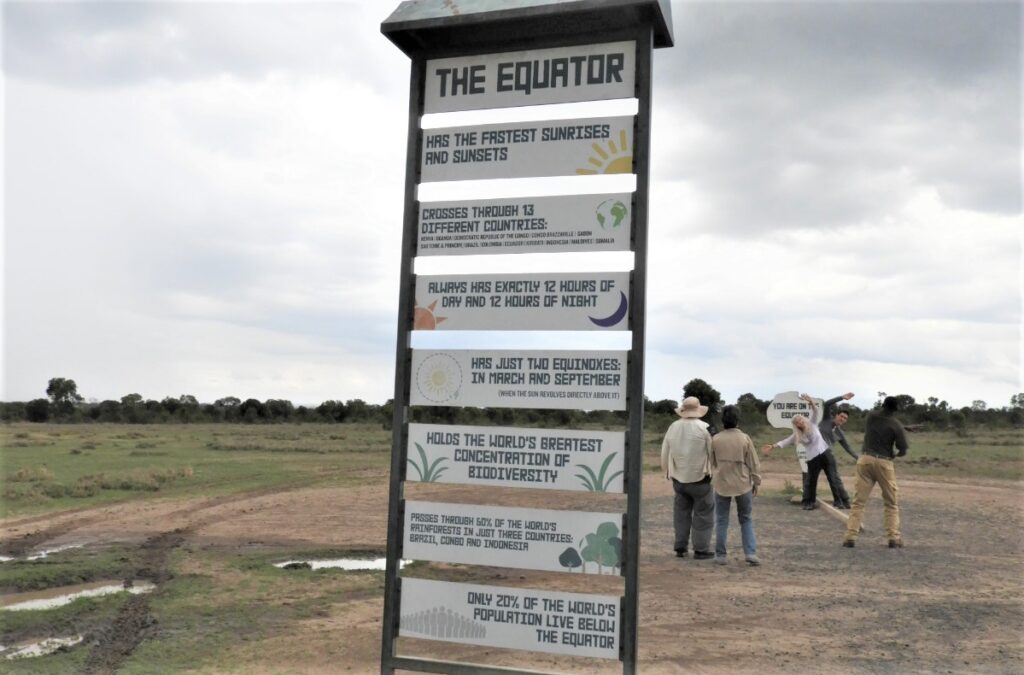 See Lois and Mike back there clowning, Guide Abdi giving them directions, Rick and Judy watching. Everybody was lining up for their turn to be ON the Equator, right there near our tent camp at Sweetwaters; right there in Ol Pejeta; right there in Kenya; right there in Africa.
See Lois and Mike back there clowning, Guide Abdi giving them directions, Rick and Judy watching. Everybody was lining up for their turn to be ON the Equator, right there near our tent camp at Sweetwaters; right there in Ol Pejeta; right there in Kenya; right there in Africa.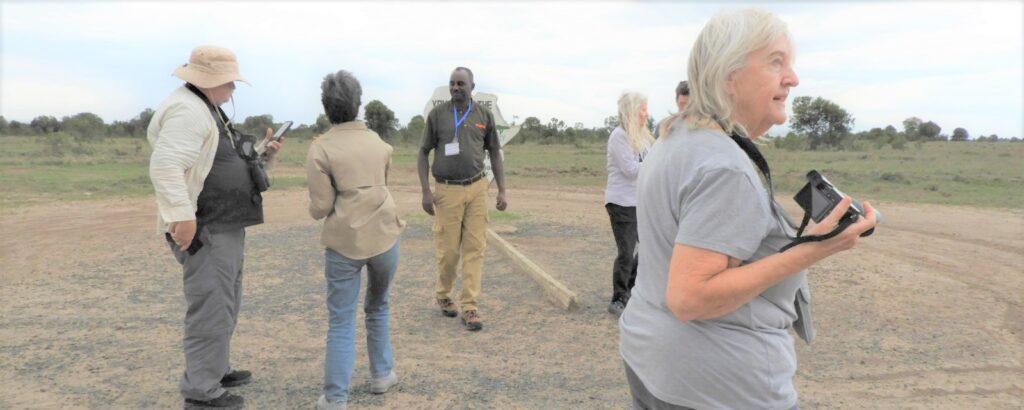
Here’s a record of our cuteness.
Rick Pointing * Rick South & Me North * Me South & Rick North * Venita South & Otis North * Ed & Maureen North * Driver Frank & The Way to Sydney * Driver Daniel & Rick & Our 4×4
» posted on Tuesday, September 13th, 2022 by Linda Lou Burton
Just Looking
Linda Lou Burton posting from Sweetwaters Serena Camp, Ol Pejeta Conservancy, Nanyuki, Kenya – Nature Walks are offered at Ol Pejeta, accompanied by a Guide, and a Guard. We passed one early on, and waved. Happy in our 4×4, we agreed, and besides, we didn’t bring our boots. 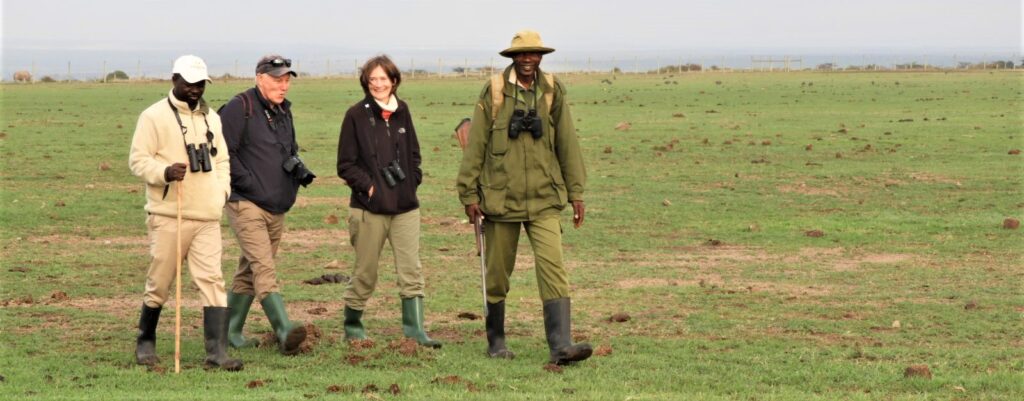
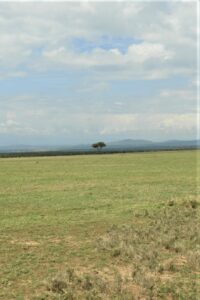 So we rode, and we rode, and we rode. I’ll stop talking for a bit and show you what we saw, in a single morning Game Drive, on the plains and hills of Africa.
So we rode, and we rode, and we rode. I’ll stop talking for a bit and show you what we saw, in a single morning Game Drive, on the plains and hills of Africa.
Look at the space – miles and miles of miles and miles. And air, and sky, and quiet.
Look at the animals behaviors — herd-friendly, or loners? Who looks after the kids? How do they help each other?
Look at the habitat they prefer – open spaces or good brush cover? Near water? Near shade? Near grass?
Cattle and herder looking for the best grass.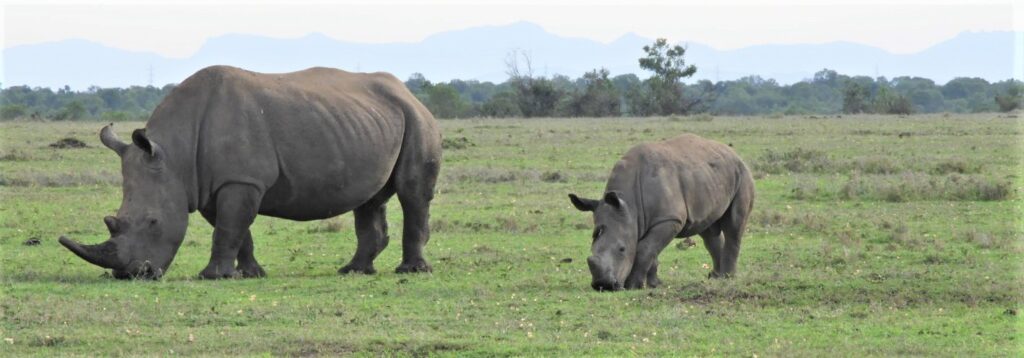
Rhino Mama and Baby looking for the next bite.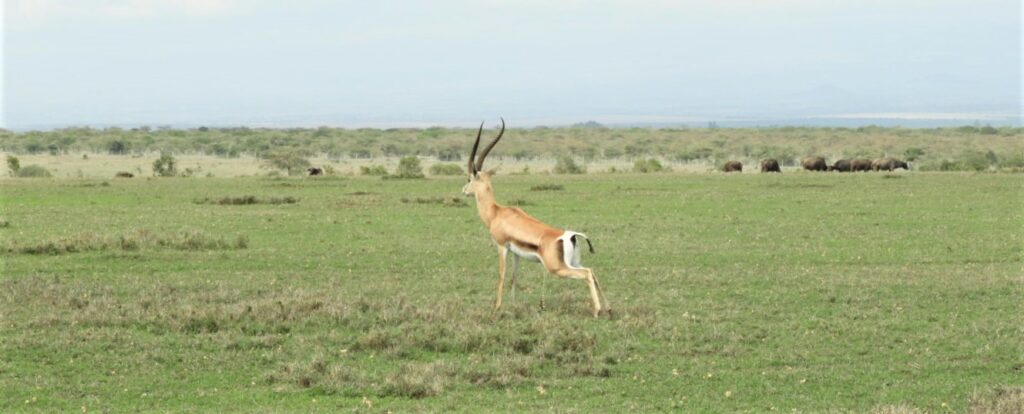
Antelope looking for relief.
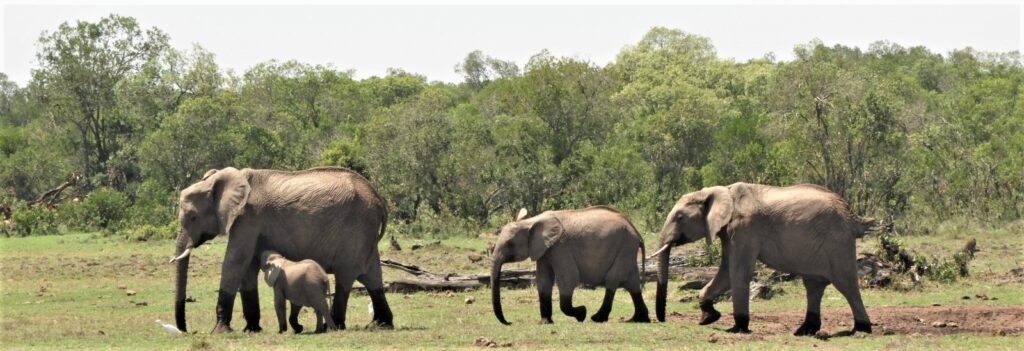 Elephant Mama and Family looking for the next stop.
Elephant Mama and Family looking for the next stop.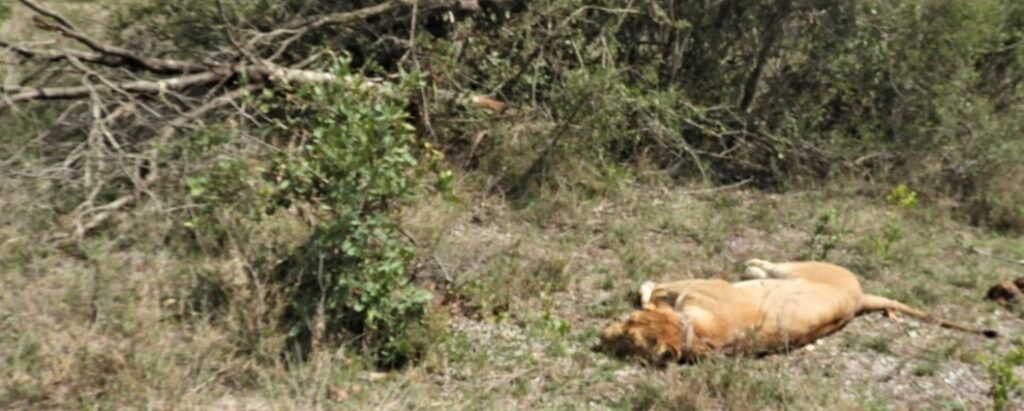
Lion Mama guarding three cubs in their brushy nest looking napping-eye at us.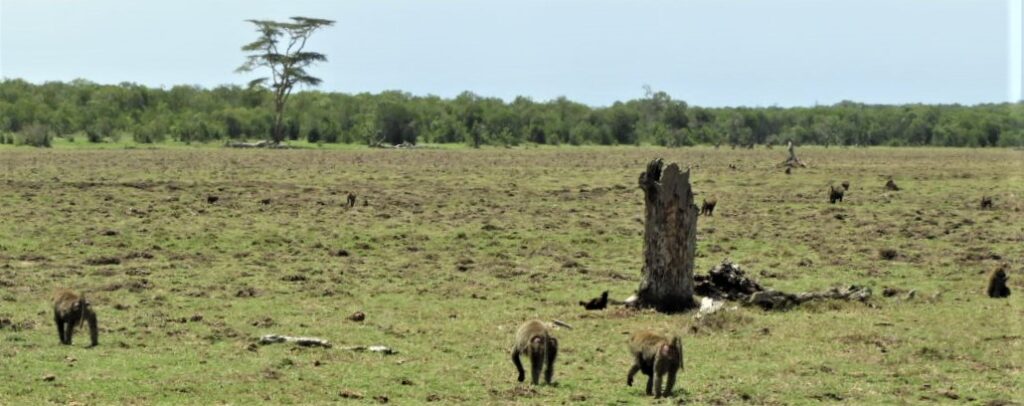
Baboon gang looking, running, shrieking like baboons.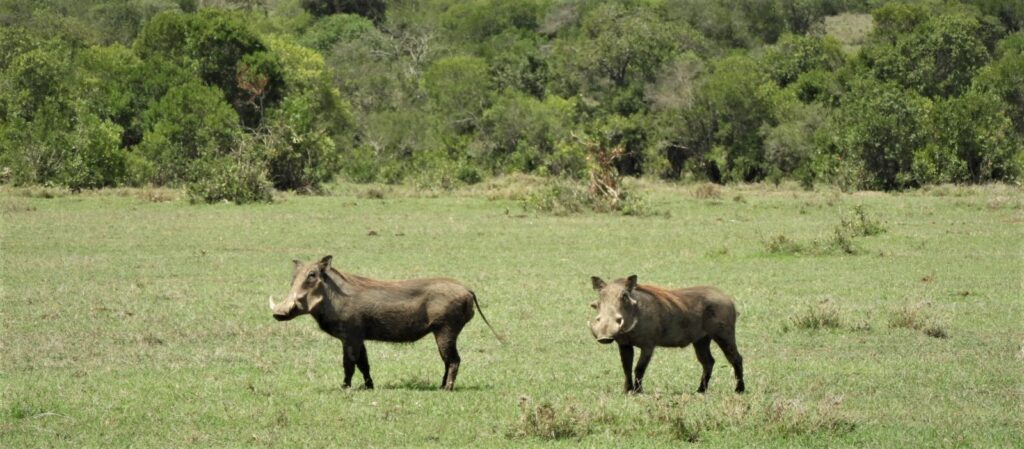
And Warthogs! They stopped grunting long enough to look at us.
That’s Tuesday morning on the Ol Pejeta, as seen from the 4×4!
Ol Pejeta Conservancy https://www.olpejetaconservancy.org/wildlife/
» posted on Tuesday, September 13th, 2022 by Linda Lou Burton
What a Shame
Linda Lou Burton posting from Sweetwaters Serena Camp, Ol Pejeta Conservancy, Nanyuki, Kenya – Sixteen gravestones; one lone tree. We’d stopped at the Rhino Cemetery, set up as a memorial honoring the lives of Ol Pejeta rhinos killed in the poaching epidemic since 2004. Abdi stood beside the gravestone of Sudan as he told us the story of the last Northern White Male Rhino on Planet Earth. That’s right, Sudan’s death in 2018 brought the end to a species; there before our eyes was a cold hard illustration of the meaning of the word EXTINCT. Hard to grasp. How does such a thing happen?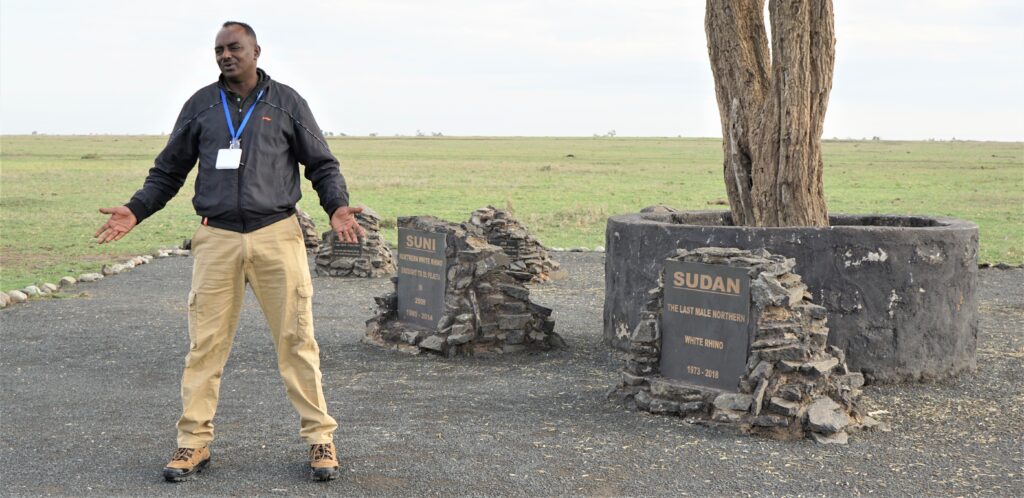
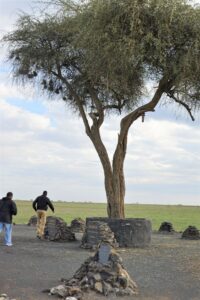 Sudan wasn’t killed by poachers; he was guarded and cared for 24/7 during the last years of his life at Ol Pejeta and died of health-related issues at age 45. But every Northern White Male Rhino before him was already gone. The group of us walked around, solemn, reading the name and cause of death on the other gravestones.
Sudan wasn’t killed by poachers; he was guarded and cared for 24/7 during the last years of his life at Ol Pejeta and died of health-related issues at age 45. But every Northern White Male Rhino before him was already gone. The group of us walked around, solemn, reading the name and cause of death on the other gravestones.
Loita. Male. Killed by poison dart. Both horns taken. Chema. Female. Snared and found dead with both horns missing. Mia. Female. Shot dead. Both horns removed. Shemsha. Female. Shot dead. Both horns removed. Kaka. Male. Killed by poison dart. Both horns taken. Ishirini. Female. Killed by poison arrow. Found writhing in pain with horns chopped off. She was 12 months pregnant.
Back in our 4×4, Abdi and Daniel fielded our questions; why is rhino horn so valuable and who is buying it? Asian markets, mainly; medicinal purposes? Prestige? It sells for more than cocaine or diamonds, and poachers show no mercy — the HORN is all they want; animals may be left to bleed to death. There are less than 25,000 rhinos left in Africa. Approximately 2,000 rhino horns went into illegal trade just last year. These numbers are jarring; I shake my head in disbelief. Just ahead a mother and baby rhino are feeding peacefully; Daniel slows.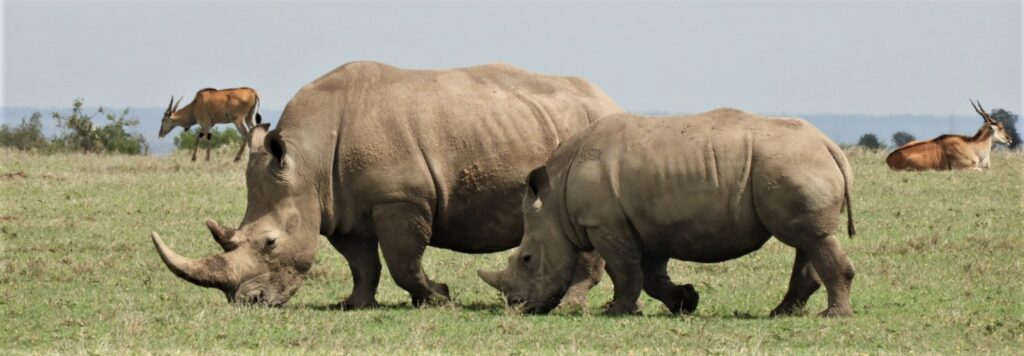
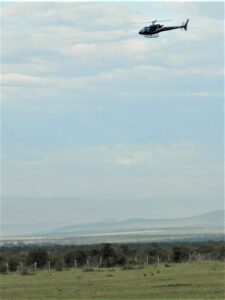 Then the noise of a chopper overhead, patrolling the vast acreage of Ol Pejeta. The rhinos didn’t notice, but I did; I was pleased to know they are being watched over so diligently. There are about 140 of the critically endangered black rhinos living here now; it’s the largest black rhino sanctuary in East Africa.
Then the noise of a chopper overhead, patrolling the vast acreage of Ol Pejeta. The rhinos didn’t notice, but I did; I was pleased to know they are being watched over so diligently. There are about 140 of the critically endangered black rhinos living here now; it’s the largest black rhino sanctuary in East Africa.
Ol Pejeta also has 39 southern white rhinos. There is no color difference between white and black rhinos; the name is a mistranslation of the Afrikaans word ‘weit’ meaning ‘wide’ – which refers to their square shaped lips used for grazing. This is the main distinction between white rhino and black. Can you tell if this browsing pair are black, or white? I can’t!
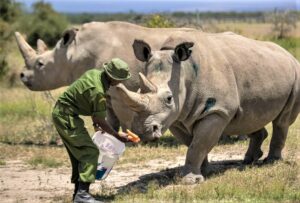 “This is the secured enclosure,” Daniel said, as he drove beside a double-wired fence. It surrounds the 700-acre 24-hr armed security area that is home to the last two northern white rhinos in the world. Najin and Fatu, mother and daughter, live here, pampered and cared for with a nutritious diet and everything else they need. Continuation of the northern white species ended with the death of Sudan in 2018; these last two girls can’t do it on their own. I found a photo of them (online) getting carrots from their keeper; living out their years as the last of their kind.
“This is the secured enclosure,” Daniel said, as he drove beside a double-wired fence. It surrounds the 700-acre 24-hr armed security area that is home to the last two northern white rhinos in the world. Najin and Fatu, mother and daughter, live here, pampered and cared for with a nutritious diet and everything else they need. Continuation of the northern white species ended with the death of Sudan in 2018; these last two girls can’t do it on their own. I found a photo of them (online) getting carrots from their keeper; living out their years as the last of their kind.
What a shame.
Ol Pejeta Conservancy, and What They’re Doing About Rhinos https://www.olpejetaconservancy.org/wildlife/rhinos/
» posted on Tuesday, September 13th, 2022 by Linda Lou Burton
Home on the Range
Linda Lou Burton posting from Sweetwaters Serena Camp, Ol Pejeta Conservancy, Nanyuki, Kenya – My first animal spotting was on Otis’s phone. He was holding it at the open window of our vehicle, yelping with excitement. “There’s a buffalo! A buffalo!”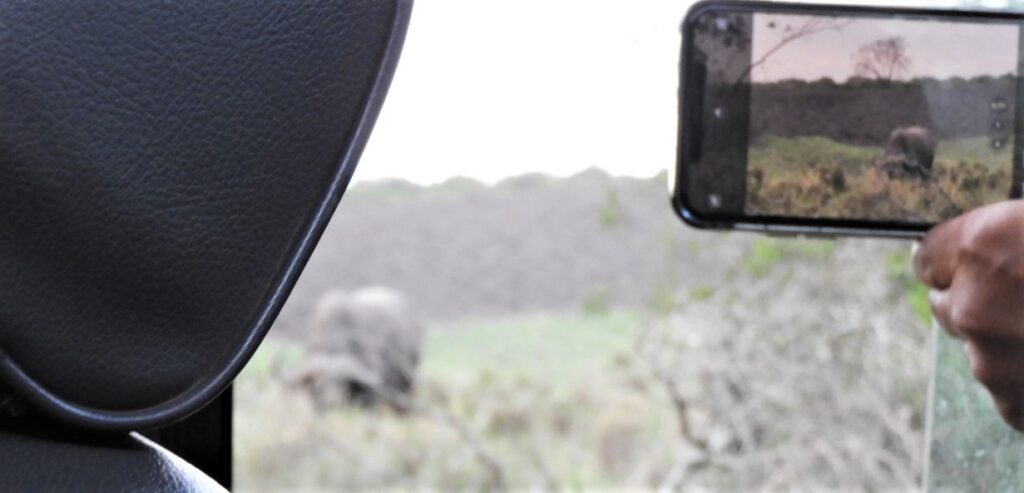
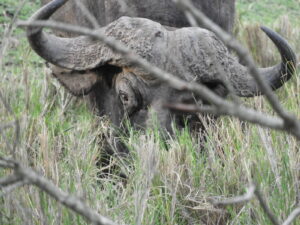 I yanked my Nikon up to the window, and (watch for it), got a bulls-eye shot. “Ha! He’s looking straight at me!” I said, as Otis and I continued to block the left-side windows. No camera courtesy in our safari behavior just yet.
I yanked my Nikon up to the window, and (watch for it), got a bulls-eye shot. “Ha! He’s looking straight at me!” I said, as Otis and I continued to block the left-side windows. No camera courtesy in our safari behavior just yet.
It didn’t matter, there were plenty of buffalo to go around. We had lucked into a herd, grazing peacefully, raising their heads now and then to give us a curious glance. Abdi and Daniel began tossing out facts; it was Buffalo Lesson time.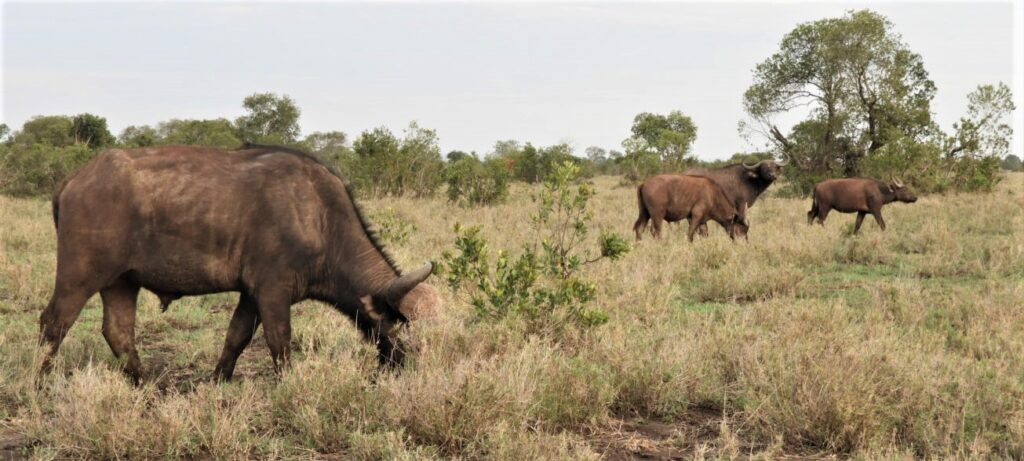
We were looking at the Cape Buffalo. I’d never seen anything like the massive set of horns on the males; that thickness across the top of the head. The bases come very close together to form a shield, referred to as a “boss,” I learned. “See how the horns curve down from there, and then up?” Daniel explained. “Sometimes the horns can reach five feet across.”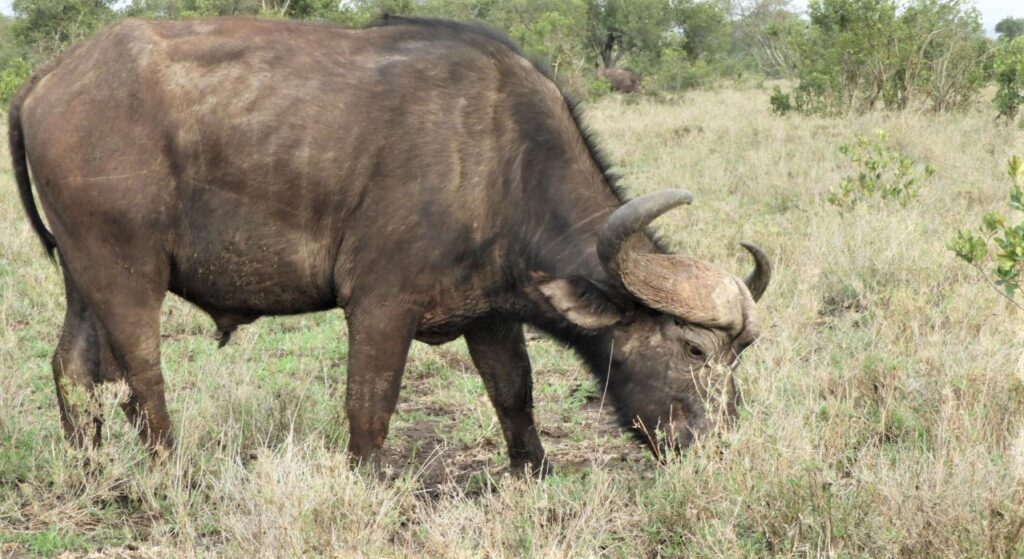
I was aware that the Cape Buffalo is on the “Big 5” list; something created years ago by hunters describing the “5 most dangerous animals to HUNT ON FOOT.” Well yes, I can see that it might be dangerous to be out walking around this big fellow. Males can weigh up to 1,900 pounds, and are strategically savvy in a game of Hide and Seek. Cape Buffalo were considered prized trophies back in the hunting days. (The others on the Big 5 List: elephant, rhinoceros, lion, leopard.) Cape Buffalo are not endangered, but do present conservation challenges due to habitat fragmentation, and conflicts with humans because of their size and aggression; something carefully monitored at Ol Pejeta.
We came up on a mother-child combo next and got a warning stare from Mama. We studied her horns, and the young ones too. Females have smaller, narrower horns, with no “boss” across the top. “Another example of males being more hard-headed than females,” someone quipped. That started us laughing, of course, just as we rounded a curve and spotted two male antelope going at each other, their long spiral horns in combat position.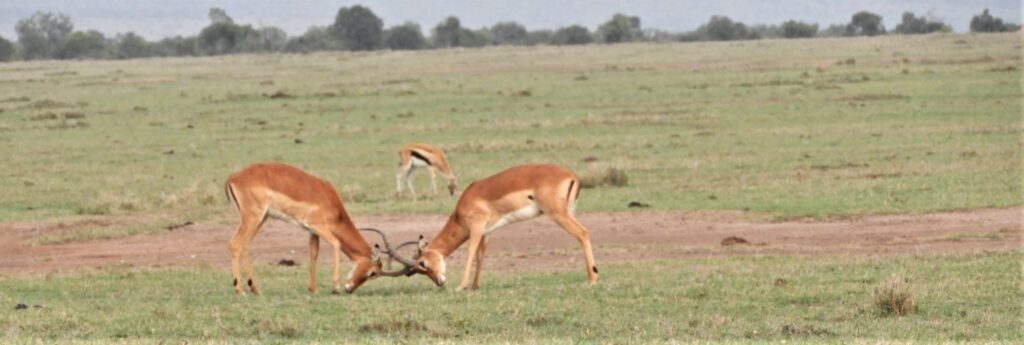
I couldn’t help myself. “Oh give me a home,” I began. Otis took up the cause, “where the buffalo roam,” and next thing you know, Rick and Venita joined in; everyone belting it out.
“And the deer and the antelope play. Where seldom is heard, a discouraging word…..,”
Just then Daniel pulled to a stop at the Rhino Cemetery.
» posted on Tuesday, September 13th, 2022 by Linda Lou Burton
Waiting for Warthogs
Linda Lou Burton posting from Sweetwaters Serena Camp, Ol Pejeta Conservancy, Nanyuki, Kenya – My eyes were as blurry as the camera lens in the pre-dawn light. I’d been up since 4:30, had my cup of tea, made one for Rick. No point in trying to sleep, it was way too noisy here. Snoring, yes. Wind flapping against the tent, yes. Animals gathering at the water hole, oh yes! Besides all those sleep deterrents, I was wide-awake excited.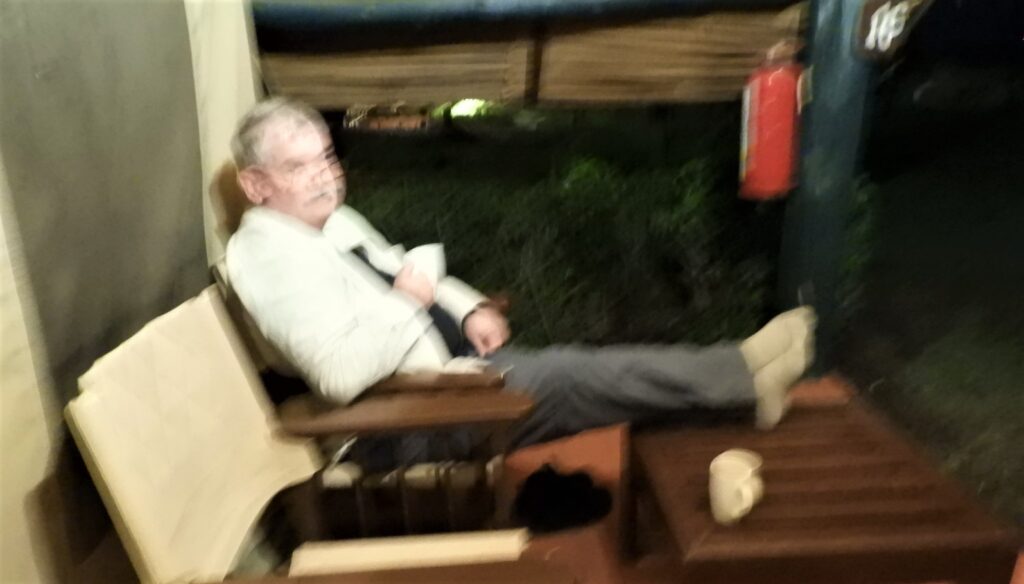
Rick was way ahead of me on the “animal count;” he’d seen elephants and buffalo and all kinds of wildlife on yesterday’s afternoon game drive while I was taking a nap. Including ugly-tusked, grunting warthogs. Now, here we sat on our porch, waiting for the sun to come up, trying to spot which animals were right in front of us.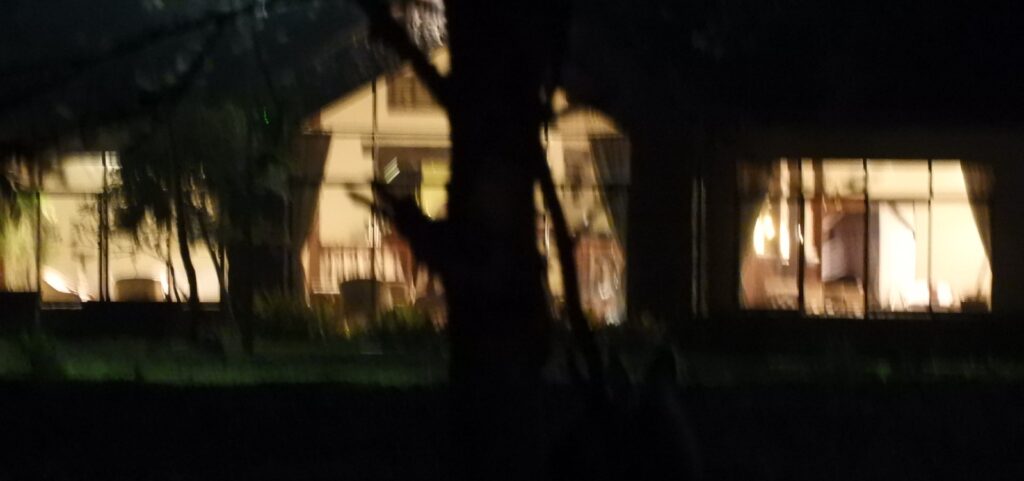
I zoomed the camera across the distance to the dining hall, all lit up; breakfast preparations underway; guides and drivers gathering to get vehicles ready, routes planned out. Was that the shadow of an impala I saw, silhouetted against the window’s light? It moved, a slow-gaited walk, neck swaying, much too long for an impala’s neck. A giraffe, perhaps? My perspective was skewed, the animal was at the water hole, the dining room way beyond that.
Sweetwaters Serena Camp is laid out around a large “water hole,” with dining room, lounge, and offices overlooking the view; Mt Kenya and its neighboring peaks the perfect backdrop. The 56 tents curve around the water hole on either side. Which means – wherever you are, you can watch the animals as they come to get a drink, and socialize.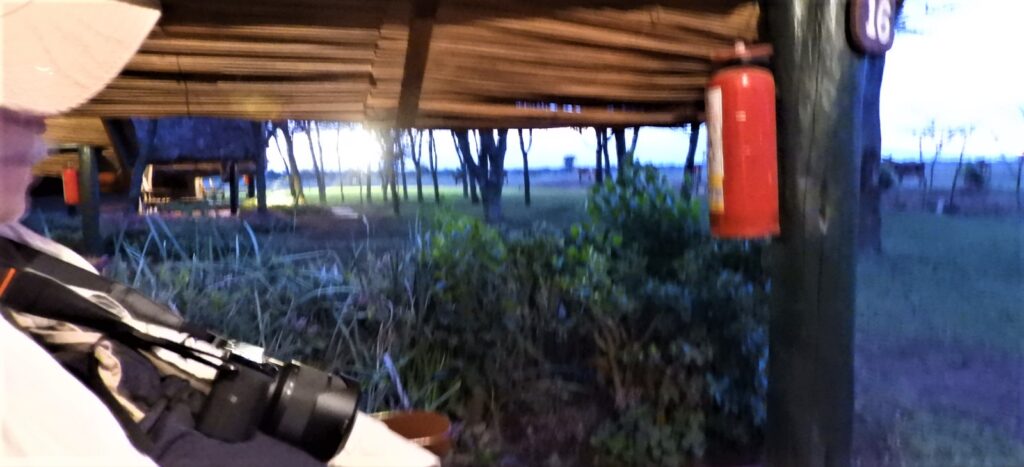
The animals can watch the people too. Now we can see a row of gentle grazers at the fence line, looking at us. “How many people start their day like this?” we wondered, back and forth, barely believing it ourselves. Just then someone stepped around the corner of our porch. It was Abdi, followed by my early-morning wheelchair driver. “Jambo! Good morning! Are you ready for a game drive today?” Abdi asked.
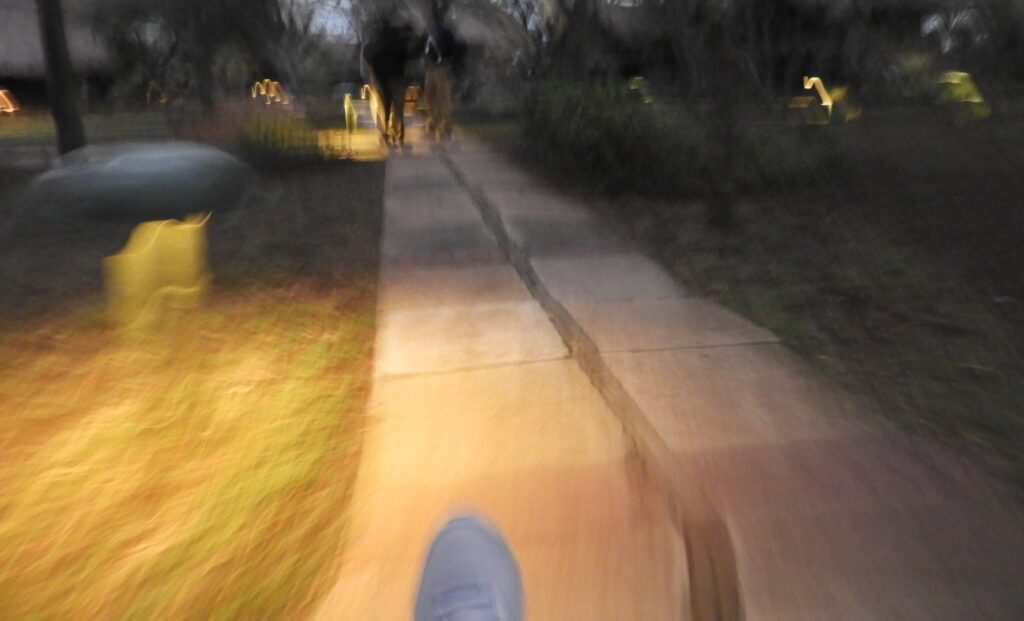 “I am indeed,” I answered, climbing into the wheelchair. That’s my foot you see, I’m shining the flashlight ahead as I’m being pushed along the bumpy path towards the dining room, and breakfast, and a day full of animal sightings — elephants, buffalo, and yes, even warthogs, I hope. That’s Abdi and Rick ahead, early-morning talk.
“I am indeed,” I answered, climbing into the wheelchair. That’s my foot you see, I’m shining the flashlight ahead as I’m being pushed along the bumpy path towards the dining room, and breakfast, and a day full of animal sightings — elephants, buffalo, and yes, even warthogs, I hope. That’s Abdi and Rick ahead, early-morning talk.
» posted on Monday, September 12th, 2022 by Linda Lou Burton
Didn’t Miss A Thing
Linda Lou Burton posting from Sweetwaters Serena Camp, Ol Pejeta Conservancy, Nanyuki, Kenya – Ever get to a place and just want to stay forever? Ever sit on a front porch and just breathe, content to do absolutely nothing? Ever had guinea fowl make such a racket you stood up to look for invaders in your yard? Believe it or not, all those things happened to me, and to Rick, in our first hour at Tent #16, Sweetwaters Serena. I’d never even heard of guinea fowl before! More precisely, I’d never HEARD guinea fowl, but that awful sound got us up and looking for the problem.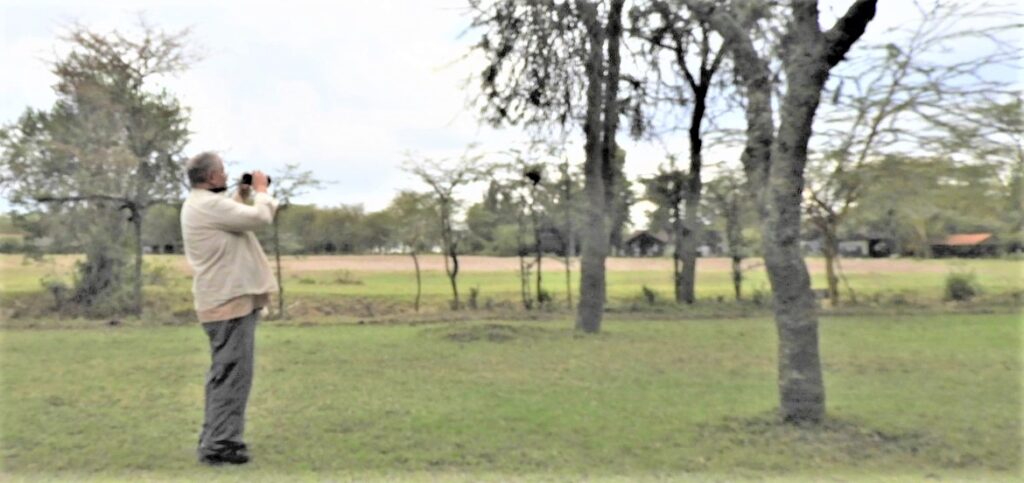
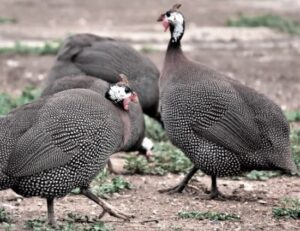 The porch of our fancy-schmancy tent faced the water hole, a distance away past the tree line. And something over there was excited; it sounded like dogs-with-a-terrible-cold barking. Use your expertise to google “guinea-fowl sounds” and you’ll see what I mean. That’s what Rick did, as we finally spotted the “helmeted chickens” all in a fuss about something. They are known as “alarmists” and considered useful (on a farm, or a wildlife preserve?) for sensing trouble.
The porch of our fancy-schmancy tent faced the water hole, a distance away past the tree line. And something over there was excited; it sounded like dogs-with-a-terrible-cold barking. Use your expertise to google “guinea-fowl sounds” and you’ll see what I mean. That’s what Rick did, as we finally spotted the “helmeted chickens” all in a fuss about something. They are known as “alarmists” and considered useful (on a farm, or a wildlife preserve?) for sensing trouble.
All that activity got Rick excited to see more animals, so he headed off to meet Abdi and Daniel and Frank and the rest of the gang for the very first Game Drive. In those 4x4s. Eek! “I’m not going anywhere!” I said. “A 5:30 wakeup today! A 5-hour drive with all that bumping and jabbering! I’m taking a NAP.”
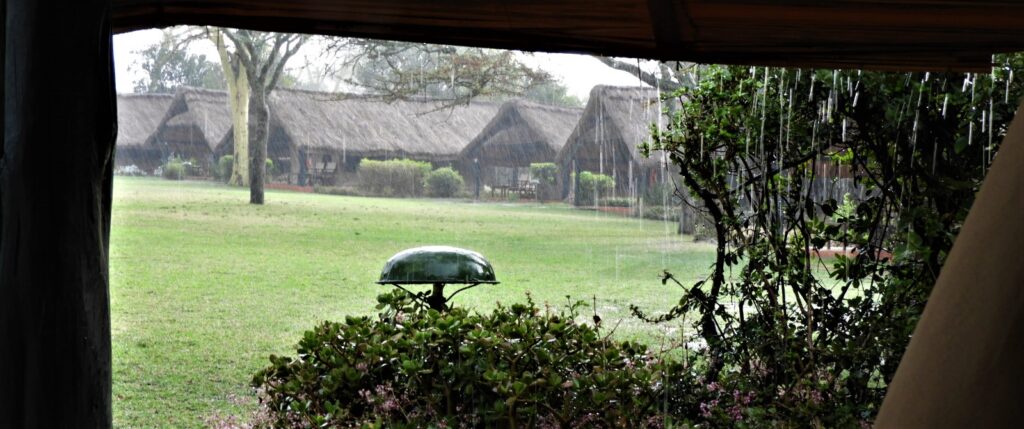 Ahhh, peace and quiet. The guinea fowl settled down. The rain began, the kind of rain that politely falls without a mess, and whispers you to sleep. I headed inside. I’ve done some camping in my day. I’ve slept in pop-up tents, with sleeping bag on the ground, campfire for cooking, and potty relief behind the nearest tree. My Sweetwaters tent was nothing like THAT. It’s called a “permanent tent” set up on a concrete (tiled and carpeted) floor, with a permanent thatched roof above.
Ahhh, peace and quiet. The guinea fowl settled down. The rain began, the kind of rain that politely falls without a mess, and whispers you to sleep. I headed inside. I’ve done some camping in my day. I’ve slept in pop-up tents, with sleeping bag on the ground, campfire for cooking, and potty relief behind the nearest tree. My Sweetwaters tent was nothing like THAT. It’s called a “permanent tent” set up on a concrete (tiled and carpeted) floor, with a permanent thatched roof above.
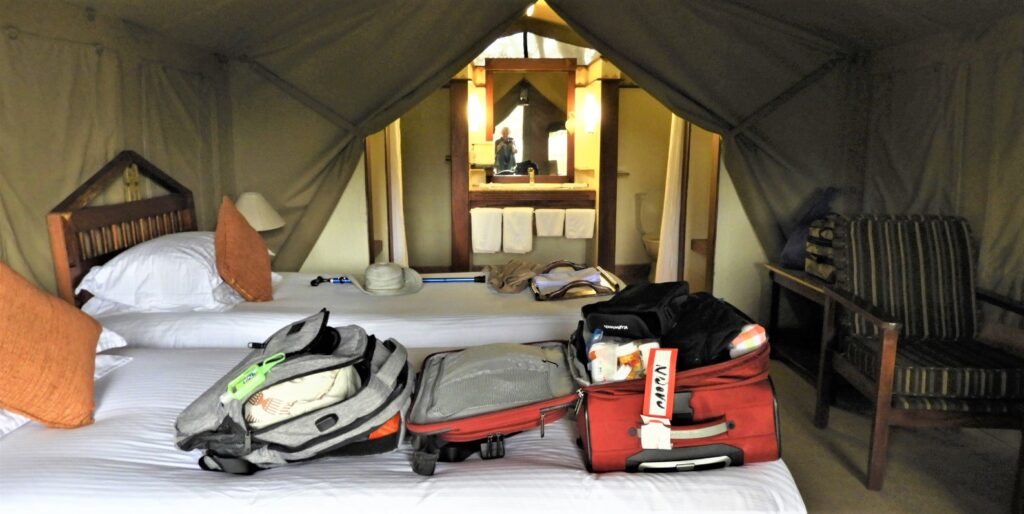 Sweetwaters Serena has 56 such tents; some are on raised platforms with balconies; ours was nearer the water hole, with a porch. Two comfy double beds. Two closets. Two robes. Two chairs inside; two out. Wi-fi and coffee station. Bath with tile shower, flush toilet, stacks of towels. Electricity! It qualified as “tented camping” because, in fact, all of this WAS inside a (very well protected) canvas tent. With windows and doors that zipped open, and closed. I left the door unzipped, and went to sleep with nary a dream of being devoured by a lion, as those who’ve-never-been-to-Africa predicted would be my demise.
Sweetwaters Serena has 56 such tents; some are on raised platforms with balconies; ours was nearer the water hole, with a porch. Two comfy double beds. Two closets. Two robes. Two chairs inside; two out. Wi-fi and coffee station. Bath with tile shower, flush toilet, stacks of towels. Electricity! It qualified as “tented camping” because, in fact, all of this WAS inside a (very well protected) canvas tent. With windows and doors that zipped open, and closed. I left the door unzipped, and went to sleep with nary a dream of being devoured by a lion, as those who’ve-never-been-to-Africa predicted would be my demise.
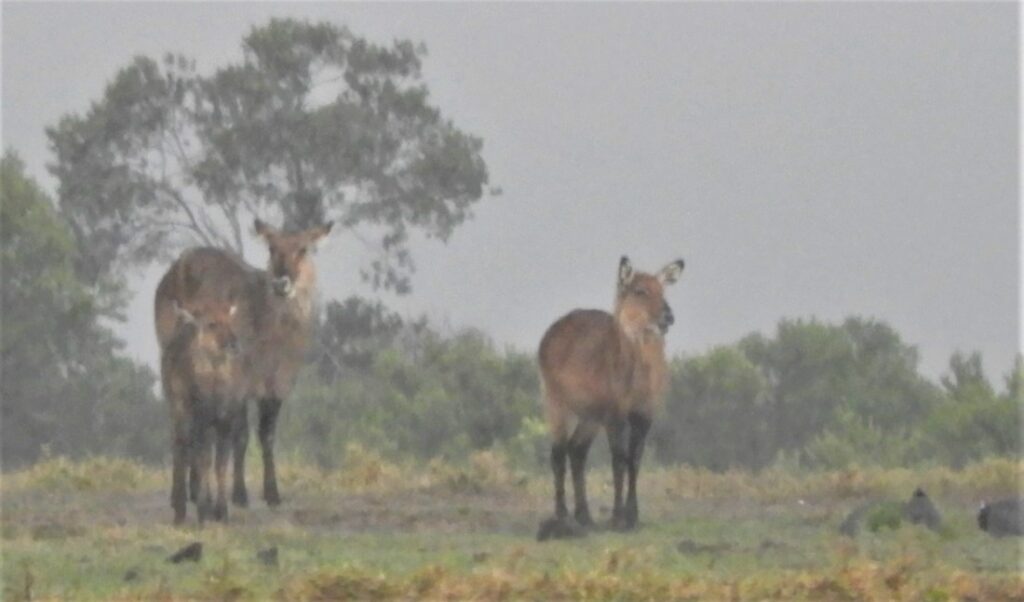 An awful squawking woke me. I’d slept an hour or so, felt rested now. I walked to the porch; a misty fog replaced the rain. I couldn’t see the water hole; zoomed my camera; caught something moving far away. It was a mother and baby impala (I think, white ears rimmed in black), with a younger impala standing peacefully beside. Coming up on the right I could see the squawking guinea fowl.
An awful squawking woke me. I’d slept an hour or so, felt rested now. I walked to the porch; a misty fog replaced the rain. I couldn’t see the water hole; zoomed my camera; caught something moving far away. It was a mother and baby impala (I think, white ears rimmed in black), with a younger impala standing peacefully beside. Coming up on the right I could see the squawking guinea fowl.
The gang would be back from their Game Drive soon, I realized. Dinner in the Rhino Room began at 7; everybody chattering; what they saw; what they did; what I missed.
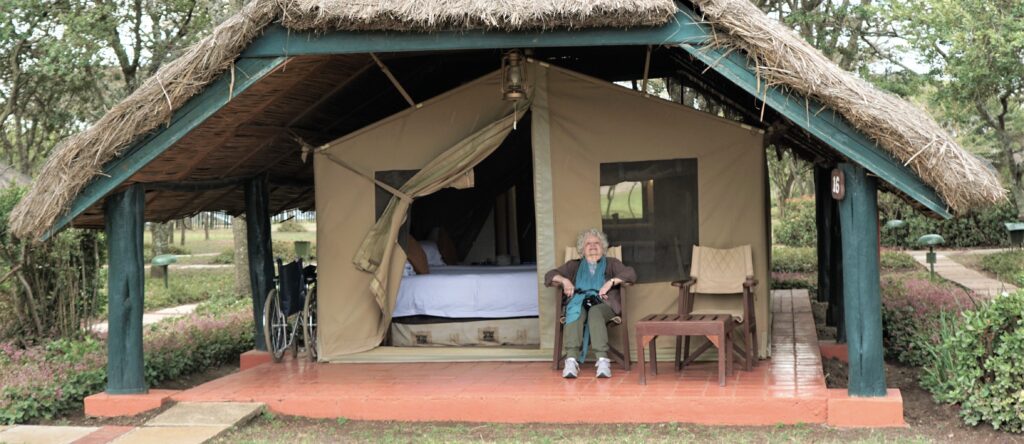 I didn’t miss a thing. There’s just something about a porch.
I didn’t miss a thing. There’s just something about a porch.
Sweetwaters Serena, Ol Pejeta Conservancy, Kenya https://www.serenahotels.com/sweetwaters
» posted on Monday, September 12th, 2022 by Linda Lou Burton
Better Than Disney
Linda Lou Burton posting from Sweetwaters Serena Camp, Ol Pejeta Conservancy, Nanyuki, Kenya – Ol Pejeta Conservancy is – well, it’s better than Disneyland! For animal lovers – it offers more than any zoo you’ve ever been to. For nature lovers – it offers more change of scene than any hike you’ve ever walked in the remotest of hills. For sheer accomplishment and impact, well, read on, in fact, go to THEIR website and spend the day learning about this magnificent place on the Equator in the foothills of Mt Kenya. https://www.olpejetaconservancy.org/
 Here are a few basics about Ol Pejeta.
Here are a few basics about Ol Pejeta.
- It’s a not-for-profit wildlife conservancy in Central Kenya’s Laikipia County, providing “innovative, tangible, sustainable conservation for wildlife and people.”
- It’s big, and broad – 90,000 acres containing 4 key habitats (plains, riverine, wetlands and mixed acacia bushland), hundreds of species and thousands of animals, and is surrounded by a population of more than 50,000 people.
- It’s home to the Big Five – lion, leopard, elephant, cape buffalo, and rhinoceros – as well as giraffes, hippos, hyenas, baboons, and endangered species like the African wild dog, cheetah and oryx.
- It’s the largest black rhino sanctuary in East Africa, with a population of over 140 black rhinos, a critically endangered species.
- It’s home to the world’s last two remaining northern white rhinos. Najin, 32, and her daughter Fatu, who is in her twenties, live in a 700-acre 24-hour secured enclosure. The last male of the species, Sudan, died in 2018.
- It’s the only place in Kenya to see chimpanzees, in a sanctuary established to rehabilitate animals rescued from the black market.
- It’s home to a herd of 6,000 bush-savvy purebred Boran cattle. Livestock-wildlife integration is beneficial to the grassland as bunched grazing breaks hardpan soil and fertilizes the ground.
- It’s supporting the people living around its borders through infrastructure and economic projects and education and healthcare efforts.
Good news for you, and me, Ol Pejeta welcomes and embraces visitors! It offers nine tented camps (Globus booked us into Sweetwaters Serena), lodges and homestays, and five campsites. Do you want pampered luxury and table-waited dining, or camping in the wild (you know, those middle-of-the night sounds when animals scratch around your tent)? Either way, you’ll wake up surrounded by NATURE, with the chance of more adventure than, well, that other place I mentioned.
And the RIDES at Ol Pejeta are in open-air 4x4s splashing through rocky creekbeds in pursuit of the latest reported elephant sighting, or pausing to watch a baby rhino and its mom feeding in the quiet of wide-open spaces, or the dark of night when the spotter’s light catches a lion couple in repose.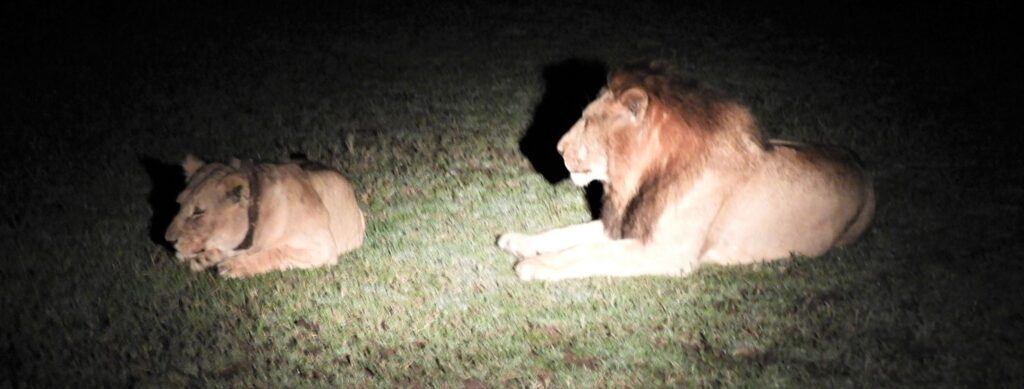
It’s a Trip Advisors Travelers Choice again this year, and 100% of profits from tourist dollars are reinvested into conservation and community development. A visit isn’t just good for you, it’s good for Kenya’s natural heritage, and its people.
The Animals: Ol Pejeta Wildlife https://www.olpejetaconservancy.org/wildlife/
The Projects: Ol Pejeta Conservation https://www.olpejetaconservancy.org/conservation/
Places to Stay and Things To Do: Ol Pejeta Escapes https://www.olpejetaconservancy.org/ol-pejeta-escapes/
Get Involved Wherever You Are: https://www.olpejetaconservancy.org/get-involved/

